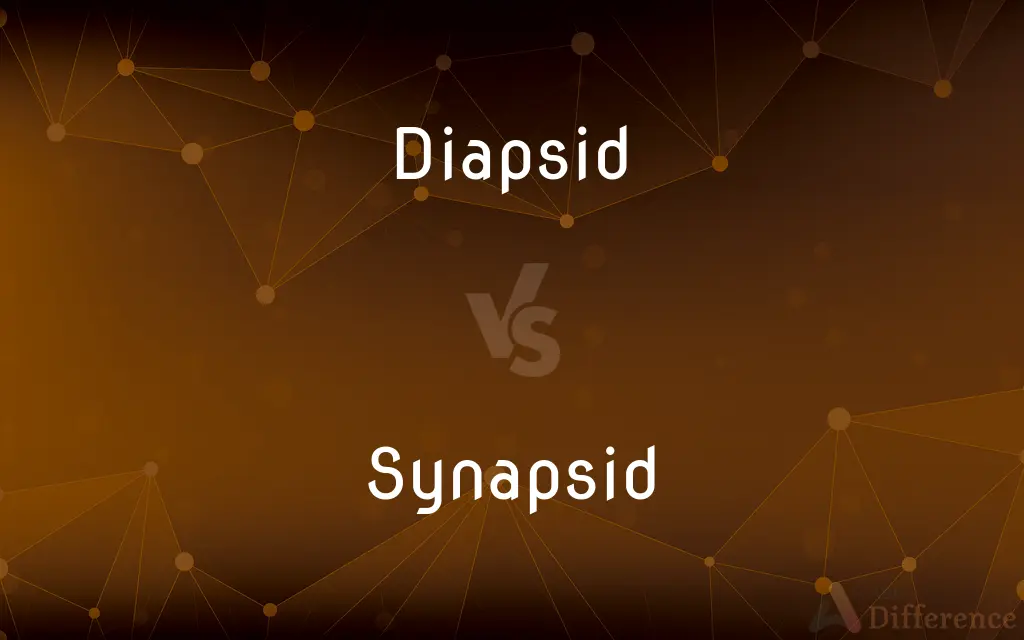Diapsid vs. Synapsid — What's the Difference?
By Tayyaba Rehman & Maham Liaqat — Updated on March 27, 2024
Diapsids possess two holes behind each eye socket for muscle attachment, aiding in jaw movement, whereas synapsids have one, influencing their skull structure and evolution.

Difference Between Diapsid and Synapsid
Table of Contents
ADVERTISEMENT
Key Differences
Diapsids are a group characterized by two temporal fenestrae (holes) located on each side of their skulls, a feature that supports a more efficient biting mechanism by providing additional space for muscle attachment. In contrast, synapsids, including mammals and their extinct relatives, have only one temporal fenestra on each side of the skull, which has influenced the evolution of their unique jaw muscles and hearing bones.
The distinction between diapsids and synapsids is not merely anatomical but also reflects their evolutionary pathways and the diversity of life forms they have given rise to. While diapsids include reptiles and birds, showcasing a wide array of biodiversity from lizards to dinosaurs and birds, synapsids are the lineage that led to mammals, marking a different trajectory in vertebrate evolution.
Diapsids’ skull structure, with its two temporal openings, allows for a greater range and strength of jaw motion, contributing to the predatory efficiency of many of its members, such as snakes and crocodiles. Synapsids, on the other hand, evolved their single temporal opening into a structure that facilitated the development of more complex jaw muscles and eventually the mammalian middle ear bones, highlighting a key evolutionary adaptation.
In terms of ecology and historical dominance, diapsids have occupied a vast range of habitats and ecological niches throughout Earth's history, from the dominant terrestrial vertebrates (dinosaurs) to modern birds and reptiles. Synapsids were the dominant terrestrial vertebrates during the Permian period, before the rise of dinosaurs, and their lineage eventually led to the diverse range of mammals seen today, from the tiniest shrew to the largest whales.
Reflecting on their evolutionary significance, diapsids and synapsids illustrate the divergent paths of vertebrate evolution, with diapsids giving rise to a majority of modern reptiles and all birds, and synapsids culminating in the mammalian lineage. This divergence highlights the adaptability and evolutionary success of both groups, despite their different anatomical and physiological adaptations.
ADVERTISEMENT
Comparison Chart
Temporal Fenestrae
Two holes on each side of the skull
One hole on each side of the skull
Members
Reptiles (excluding turtles) and birds
Mammals and their extinct relatives
Evolutionary Significance
Led to the diversity of reptiles and birds
Led to the evolution of mammals
Skull Structure
Allows greater range of jaw motion
Supports complex jaw muscles and hearing bones
Ecological Dominance
Varied, includes dinosaurs and modern reptiles/birds
Dominant in the Permian, now includes all mammals
Compare with Definitions
Diapsid
A clade characterized by skulls with two temporal fenestrae, leading to diverse reptilian and avian lineages.
The diapsid skull structure can be observed in modern birds and many reptiles.
Synapsid
A clade distinguished by a single temporal fenestra on each side of the skull, a feature leading to the mammalian lineage.
The synapsid skull design facilitated the development of distinctive mammalian features, including advanced hearing.
Diapsid
Diapsids include both ectothermic reptiles and endothermic birds, illustrating a wide range of metabolic strategies.
The metabolic diversity among diapsids spans from the cold-blooded snakes to the warm-blooded birds.
Synapsid
Synapsids include the ancestors of all modern mammals, reflecting an evolutionary history of adaptation and diversification.
From tiny burrowers to giant herbivores, synapsids have evolved into the myriad forms of mammals we see today.
Diapsid
Members exhibit a range of ecological adaptations, from flight in birds to aquatic lifestyles in some reptiles.
Diapsids show incredible diversity, including the flying abilities of birds and the aquatic nature of crocodiles.
Synapsid
The transition from reptile-like ancestors to true mammals involved significant changes in physiology and behavior.
Synapsid evolution is marked by the transition to warm-bloodedness and the development of fur or hair.
Diapsid
The group's adaptability is evidenced by their survival and evolution into a broad array of species across geological eras.
Diapsids have evolved to fill numerous ecological niches over millions of years, from predators to prey.
Synapsid
They were once the dominant terrestrial vertebrates, with a wide variety of forms before the rise of dinosaurs.
During the Permian period, synapsids were the top predators and herbivores before the mass extinction events.
Diapsid
Their evolutionary path showcases a significant role in Earth's prehistoric ecosystems, especially dinosaurs.
Diapsid dinosaurs once dominated terrestrial ecosystems before the advent of mammals.
Synapsid
Modern mammals, from the largest whales to the smallest rodents, are descendants of ancient synapsid ancestors.
The vast diversity of mammals, including humans, owes its origins to the synapsid lineage.
Diapsid
Diapsids ("two arches") are a group of amniote tetrapods that developed two holes (temporal fenestra) in each side of their skulls about 300 million years ago during the late Carboniferous period. The diapsids are extremely diverse, and include all crocodilians, lizards, snakes, tuatara, turtles, and birds.
Synapsid
Synapsids are a group of animals that includes mammals and every animal more closely related to mammals than to the other members of the amniote clade, such as reptiles and birds. Unlike other amniotes, they have a temporal fenestra, an opening low in the skull roof behind each eye, leaving a bony arch beneath each; this accounts for their name.
Diapsid
Any of a group of amniote vertebrates that are characterized by two openings in the temporal region on each side of the skull. The first diapsids emerged in the Pennsylvanian Period, and their descendants include the lizards, snakes, crocodiles, dinosaurs, pterosaurs, birds, and, in some classifications, the turtles.
Synapsid
Any of a group of amniote vertebrates that first emerged in the late Permian Period, characterized by a single opening in the temporal region on each side of the skull and including the mammals along with various extinct groups more closely related to mammals than to other amniotes.
Diapsid
(zoology) Any of very many reptiles, of the subclass Diapsida, that have a pair of openings in the skull behind each eye
Synapsid
Pertaining to the class Synapsida, of animals which have an opening low in the skull roof behind each eye, leaving a bony arch beneath each.
Diapsid
Reptile having a pair of openings in the skull behind each eye
Synapsid
Any animal (including all mammals) of the class Synapsida.
Synapsid
Extinct reptile having a single pair of lateral temporal openings in the skull
Common Curiosities
What is a synapsid?
A synapsid is an animal with a single temporal fenestra per side of its skull, including mammals and their extinct relatives.
What is a diapsid?
A diapsid is an animal with two temporal fenestrae in its skull, including most reptiles and all birds.
Why do diapsids have two skull openings?
The two openings in diapsids allow for stronger and more efficient jaw muscles, aiding in their predatory lifestyle.
How did synapsids evolve into mammals?
Synapsids evolved into mammals through gradual changes in their skull structure, leading to improved jaw mechanics and hearing capabilities.
Can you give an example of a diapsid animal?
Examples of diapsid animals include snakes, lizards, crocodiles, and all bird species.
What evolutionary advantage does the diapsid skull provide?
The diapsid skull structure provides evolutionary advantages in terms of enhanced bite strength and jaw mobility.
What distinguishes synapsids from reptiles?
Synapsids are distinguished from reptiles by their unique skull structure with one temporal opening, leading to the evolution of mammals.
Are dinosaurs considered diapsids?
Yes, dinosaurs are considered diapsids due to their skull structure with two temporal fenestrae.
What role did synapsids play in prehistoric ecosystems?
Synapsids were dominant terrestrial vertebrates in the Permian period, playing key roles as predators and herbivores.
What are the key evolutionary milestones of synapsids?
Key milestones include the development of a single temporal fenestra, differentiation of teeth, and the evolution of mammalian ear bones.
Share Your Discovery

Previous Comparison
Tuesday vs. Thursday
Next Comparison
Vision vs. DreamAuthor Spotlight
Written by
Tayyaba RehmanTayyaba Rehman is a distinguished writer, currently serving as a primary contributor to askdifference.com. As a researcher in semantics and etymology, Tayyaba's passion for the complexity of languages and their distinctions has found a perfect home on the platform. Tayyaba delves into the intricacies of language, distinguishing between commonly confused words and phrases, thereby providing clarity for readers worldwide.
Co-written by
Maham Liaqat













































